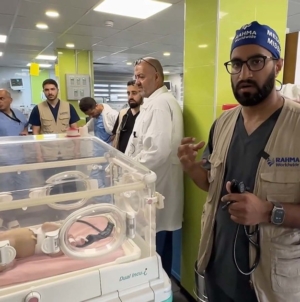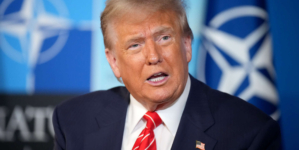-
Arrest made after teen senselessly killed while riding his bike - 2 mins ago
-
Who were the biggest sleepers of Round 1 of the 2025 NBA Draft? | First Things First - 7 mins ago
-
Appeals court ends California A.G.’s prosecution of top Gascón advisor - 14 mins ago
-
U.S. doctor working in Gaza decries lack of baby formula for malnourished infants - 21 mins ago
-
Trump’s Immigration Approval Rating Hits New Low, Poll Shows - 26 mins ago
-
Ohio woman sentenced to life for raping an infant - 46 mins ago
-
Justice Department launches hiring discrimination investigation of UC - 53 mins ago
-
Shohei Ohtani crushes solo home run, extending Dodgers' lead over Rockies - 55 mins ago
-
‘Spider-Man’ Director Reveals Why He Quit ‘Fantastic Four’ - about 1 hour ago
-
Man who killed ex in front of her son, kept voodoo doll, and defaced photos of her is sentenced - about 1 hour ago
The Major Trump Question Left Unanswered at NATO Summit
One big question was left unanswered at NATO’s biggest summit of the year, and only America’s delegation could answer it.
But the U.S. did not discuss with its allies any plans to roll back the American troop presence in Europe, according to two European officials at The Hague gathering this week.
The U.S. has indicated a strong desire to pull resources from the continent as it pivots toward the Indo-Pacific and contends with the fallout of its strikes on Iran over the weekend. But when and by how much remains a mystery.
Matthew Whitaker, the U.S. ambassador to NATO, said last month “nothing has been determined” on the potential pullback of U.S. troops in Europe, but serious conversations would happen after the alliance’s summit in the Netherlands.
“We just need to work through the practical consequences,” Whitaker said in May.
There was “not a single word” from President Donald Trump or Defense Secretary Pete Hegseth about U.S. troops in Europe at official meetings in The Hague on Tuesday and Wednesday, a European defense official told Newsweek. He and another official were granted anonymity to speak freely about the diplomatic discussions.
AP Photo/Czarek Sokolowski
The silence on the future of U.S. troops in Europe was “intentional,” and a decision to be taken by Washington alone despite strong European interest, the second official told Newsweek.
European countries have relied heavily on the U.S. for decades, and the prospect of America moving the tens of thousands of troops currently on the continent elsewhere has been, for many, an unwelcome thought.
The U.S. has major bases across Europe, providing some of the alliance’s most expensive capabilities as well as a sending a strong signal of Washington’s commitment to the defense of Europe in the face of Russia.
The Pentagon is in the middle of a review of its global forces, which is expected to be finished in the late summer or early fall.
Whitaker said ahead of the NATO summit that Washington would “work hand in glove” with other members of the alliance, including Canada, to make sure there are “no security gaps” if the U.S. moves its capabilities away.
The process for withdrawing U.S. troops from Europe would likely be lengthy and expensive. It would cost European countries $1 trillion over the next 25 years to replace all of the capabilities and equipment the U.S. currently provides for the continent, according to an estimate from the International Institute for Strategic Studies (IISS), published last month. On the U.S. side, it’s not clear where many additional troops would be housed
Even if European NATO members received no answers on U.S. troop presence, the gathering in The Hague appears to have placated Trump, who for months overtly criticized the rest of the alliance for failing to invest in defense.
The President, who had in the past suggested he would encourage Russian attacks on NATO members he felt weren’t paying enough, told the alliance’s other members he is “with them all the way.”
NATO heads of state on Wednesday officially signed off on a new pledge to raise defense and related spending to 5 percent of GDP in the next decade. A 3.5 percent chunk of it will be for military capabilities, or “hard defense,” while the remaining 1.5 percent will be funneled into defense-related infrastructure investment, from cyber capabilities to making sure strategic bridges can bear the weight of tanks and armored vehicles.
Even a few months ago, agreement on U.S. calls for NATO members to spend 5 percent had seemed impossible, despite European officials admitting they had not been paying enough.
Speaking at his highly anticipated press conference on Wednesday, Trump praised the “highly productive” summit while singling out Spain for a handful of pointed remarks.
Spain’s government has said it will be able to fulfill the new capability targets without reaching 3.5 percent of GDP on core defense spending. Fresh capability targets were agreed by defense ministers at the start of June.
Rutte told journalists on Monday that the alliance was “absolutely convinced” Madrid could not meet these requirements without the extra spending.
“They want to stay at 2 percent—I think it’s terrible,” Trump said. “I don’t know what the problem is. I think it’s too bad.”
Countries on NATO’s eastern flank, close to Russia, have stormed ahead with steep hikes to defense spending, while western and southern Europe have lagged behind.
Source link































